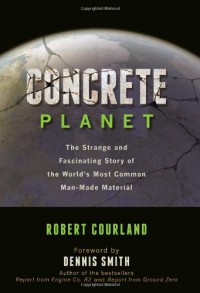
CONCRETE PLANET by Robert Courland

TITLE: Concrete Planet: The Strange and Fascinating Story
of the World's Most Common Man-Made Material
AUTHOR: Robert Courland
DATE PUBLISHED: 2011
FORMAT: ebook
ISBN-13: 978-1-61614-482-1
_______________________________________
From the blurb:
"Concrete: We use it for our buildings, bridges, dams, and roads. We walk on it, drive on it, and many of us live and work within its walls. But very few of us know what it is. We take for granted this ubiquitous substance, which both literally and figuratively comprises much of modern civilization’s constructed environment; yet the story of its creation and development features a cast of fascinating characters and remarkable historical episodes. This book delves into this history, opening readers’ eyes at every turn.
In a lively narrative peppered with intriguing details, author Robert Corland describes how some of the most famous personalities of history became involved in the development and use of concrete—including King Herod the Great of Judea, the Roman emperor Hadrian, Thomas Edison (who once owned the largest concrete cement plant in the world), and architect Frank Lloyd Wright. Courland points to recent archaeological evidence suggesting that the discovery of concrete directly led to the Neolithic Revolution and the rise of the earliest civilizations. Much later, the Romans reached extraordinarily high standards for concrete production, showcasing their achievement in iconic buildings like the Coliseum and the Pantheon. Amazingly, with the fall of the Roman Empire, the secrets of concrete manufacturing were lost for over a millennium.
The author explains that when concrete was rediscovered in the late eighteenth century it was initially viewed as an interesting novelty or, at best, a specialized building material suitable only for a narrow range of applications. It was only toward the end of the nineteenth century that the use of concrete exploded. During this rapid expansion, industry lobbyists tried to disguise the fact that modern concrete had certain defects and critical shortcomings. It is now recognized that modern concrete, unlike its Roman predecessor, gradually disintegrates with age. Compounding this problem is another distressing fact: the manufacture of concrete cement is a major contributor to global warming.
Concrete Planet is filled with incredible stories, fascinating characters, surprising facts, and an array of intriguing insights into the building material that forms the basis of the infrastructure on which we depend."
There isn't much to say about this book that hasn't already been mentioned in the blurb. The book is a well-written, accessible and enjoyable history of concrete and some of the structures built with it. I did feel the history of concrete in the 20th century dealt more with the people involved than what the concrete was actually used for. It would also have been nice if the author had inserted chemical equations etc - at least as an appendix - but otherwise it's an informative book about the subject matter.



